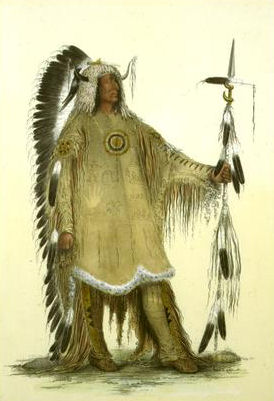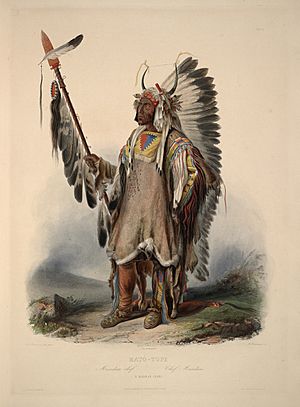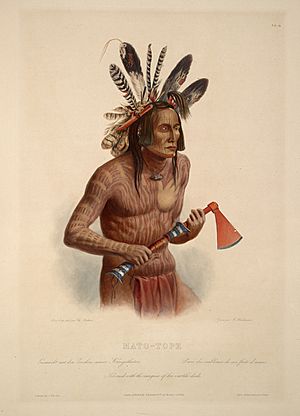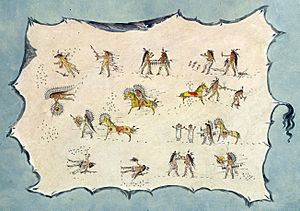Mato-tope facts for kids
Quick facts for kids
Mato-tope
|
|
|---|---|

Mah-to-toh-pe by George Catlin
|
|
| Born | c. 1784 |
| Died | July 30, 1837 |
| Occupation | Chief of the Mandan tribe |
Mato-tope (also known as Ma-to-toh-pe or Four Bears) was an important leader of the Mandan tribe. His name, "Four Bears," came from his bravery in battle. He was said to fight with the strength of four bears.
Four Bears lived in the early 1800s near the Missouri River in what is now North Dakota. He was a favorite subject for famous artists like George Catlin and Karl Bodmer.
Contents
Growing Up: Four Bears' Early Life
Four Bears grew up in a traditional earth lodge. His father, Good Boy, was a village chief. The family lived in a Mandan village called On-a-Slant Village. Later, they moved to another village called Mitutanka, which was founded around 1822.
A Brave Warrior: Four Bears' Battles
Around 1830, a trading post called Fort Clark was built near Mitutanka. By this time, Four Bears was known as a very brave warrior. He was famous for defeating a Cheyenne chief in a hand-to-hand fight.
Four Bears also fought against other tribes, including the Sioux, the Arikara, and the Assiniboine. He was known for his daring acts. Once, he sought revenge for his younger brother's death. He learned who the killer was through a special ceremony.
Artists like George Catlin and Prince Maximilian zu Wied collected special robes that showed Four Bears' brave deeds. These robes were like picture stories of his victories. Even though he was a successful warrior, Maximilian described Four Bears as being a bit slim and of average height.
A Community Leader: Four Bears' Public Role
Four Bears was a very important person in his tribe. He owned a special "People Above bundle," which was one of only five among the Mandans. These bundles were sacred and held great meaning.
He also led the most important ceremony of his tribe, called the Okipa, two times. This shows how respected he was. As a leader, he lived in an earth lodge right across from the ceremonial lodge in the village plaza.
George Catlin, the artist, admired Four Bears greatly. Catlin said that Four Bears was a man of freedom, generosity, and grace. He believed Four Bears was one of the most amazing Native Americans he had ever met.
Four Bears' Family Life
Four Bears' wife was named Brown Woman. They had several children, though the exact number is not clear. One of their daughters was known as Earth Woman.
When Prince Maximilian and artist Karl Bodmer visited in 1833, Four Bears greeted them with his wife and a young boy. This boy might have been his son, who later became known as Bad Gun (or Rushing After The Eagle).
Bad Gun survived the terrible smallpox epidemic of 1837. He later became a chief in the combined Mandan, Hidatsa, and Arikara settlement called Like-a-Fishhook Village. He became a leader partly because of his famous father.
Meeting European Visitors
Four Bears became friends with the artist Karl Bodmer in 1833. He spent time teaching Prince Maximilian his own Mandan language. He also taught him the Arikara language, which was very different, but Four Bears spoke it well. Four Bears became the main chief of his tribe in 1836.
The Death of Four Bears
In 1837, a terrible smallpox epidemic swept across the Great Plains. This disease was brought by white settlers. It wiped out most of Four Bears' tribe. Out of about 2,000 Mandan people, only 27 (or perhaps 100 to 150) survived.
Four Bears himself died on July 30, 1837, after suffering from smallpox. Before he died, he lost his wife and possibly some of his children to the disease. The manager of Fort Clark, Francis A. Chardon, wrote that Four Bears was "regretted by all who Knew him."
Before his death, Four Bears gave a powerful speech to the neighboring Arikara and Hidatsa tribes. He expressed his deep sadness and anger towards the white men, whom he had once treated as brothers, for bringing the disease that destroyed his people. He spoke of how the disease had disfigured him. Some accounts say he starved himself to death out of grief, but many believe he died from smallpox.
The smallpox epidemic was devastating. It killed more than 80 percent of the Mandan population in just a few months. Many other tribes also suffered greatly from the disease.
A later leader, Edward Lone Fight, who was Chairman of the Mandan, Hidatsa and Arikara Nation, was a descendant of Four Bears.
Honoring Four Bears' Legacy
Four Bears is remembered and honored in several ways. The Four Bears Bridge and the Four Bears Casino and Lodge are named after him and a Hidatsa chief with the same name.
A mountain in Glacier National Park is also named after him, though it is spelled slightly differently as Mahtotopa Mountain.
|




